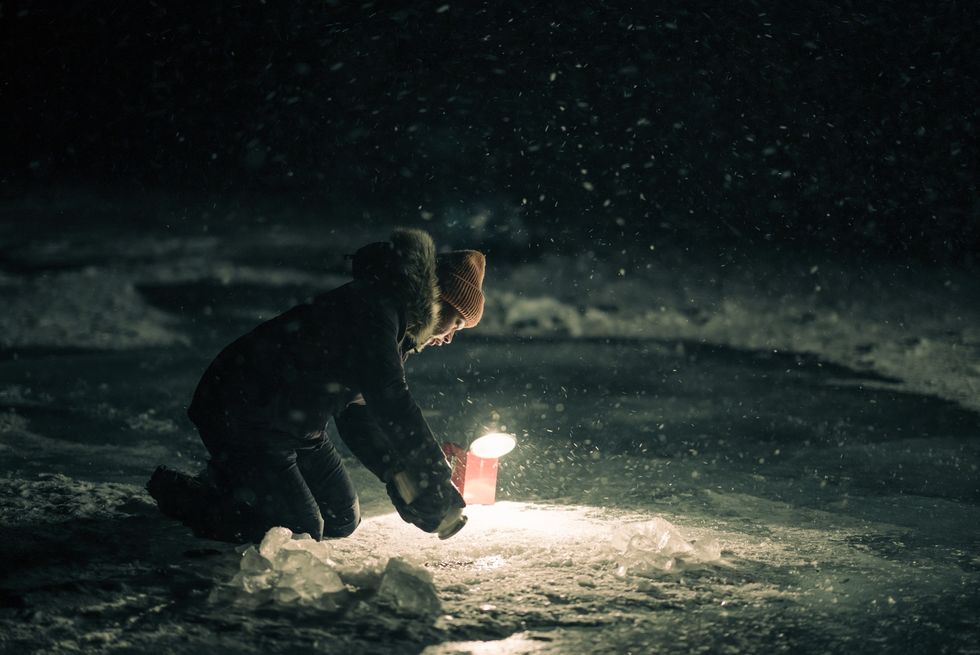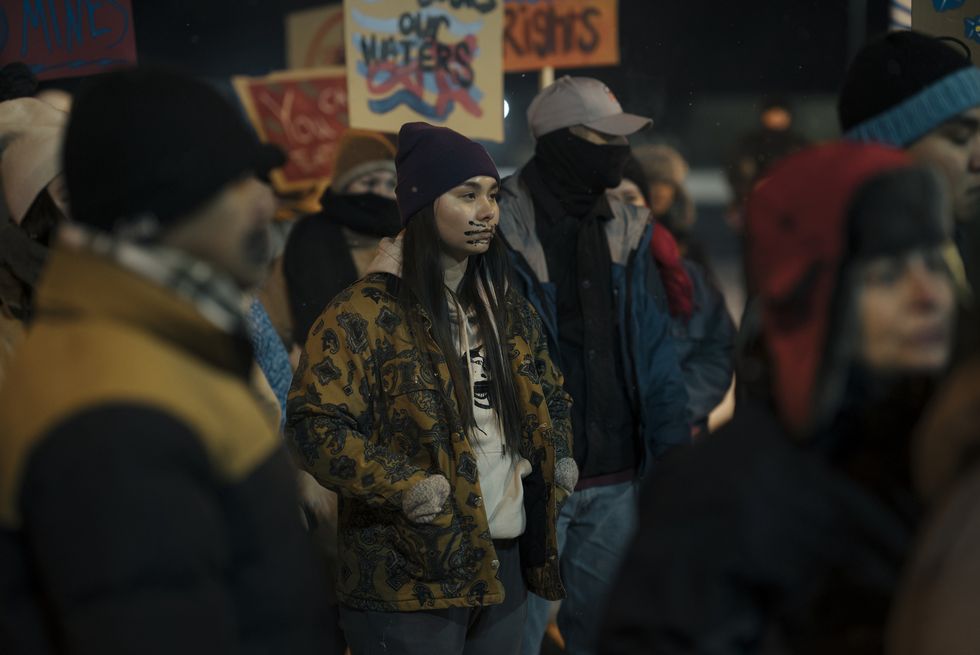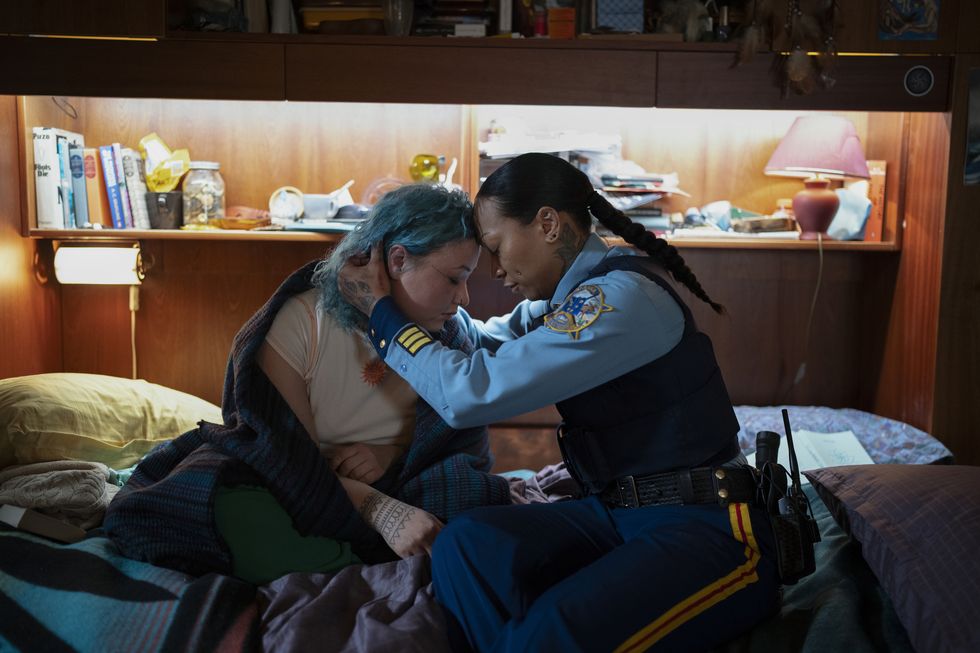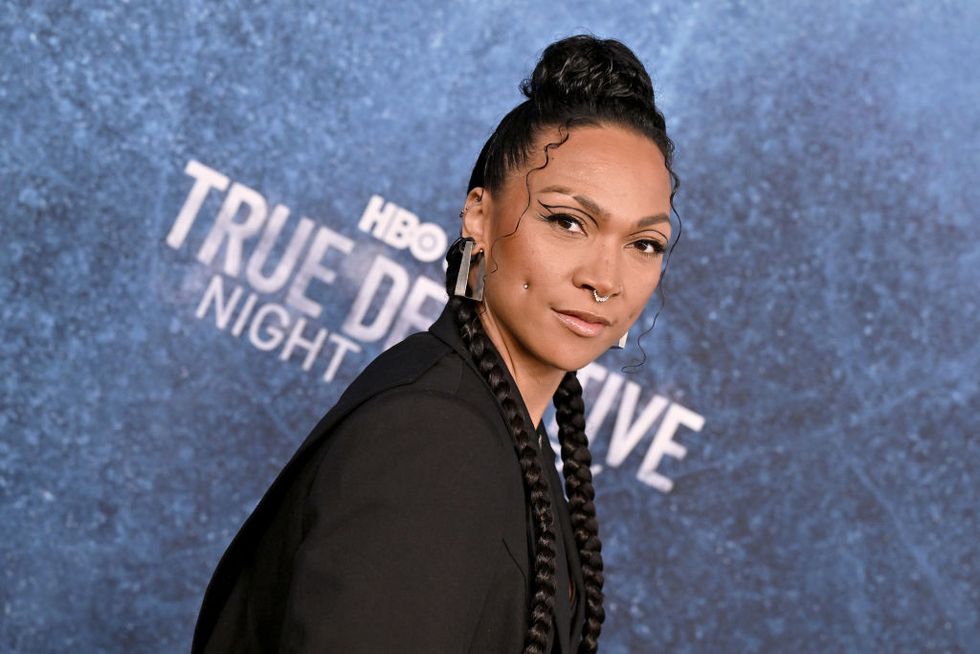Spoilers for True Detective: Night Country below.
Kali Reis is loving your True Detective theories. “Oh, the theories are my favorite right now. I love to see people so invested. They take a hard left and I’m like, ‘Wow. Okay. All right.’”
Over the past six weeks, Reis, a boxer, actress, and Indigenous activist, has been keeping the internet on its toes as she co-stars with Jodie Foster in True Detective: Night Country’s icy whodunnit from showrunner Issa López. After tonight’s finale, the fan investigations are only bound to continue.
“It goes along with the theme of suggesting you to believe what you want to believe,” Reis says. “Whether you want to rock with the Navarro-esque of the spiritual supernatural things you don’t see, you want to keep it really Liz Danvers logical, rational, but it’s not a demand you have to believe this is the only answer. It’s a suggestion, which I also think it’s helpful with the audience to feel like they’re involved in the case, not just watching, but they’re really involved in it… Everybody’s acting like a real true detective watching this to try to figure it out. It’s really cool.”
Annie’s Death
The episode begins with Liz Danvers (Jodie Foster) and Evangeline Navarro (Reis) falling through the ice and into a web of tunnels, presumably the same spot where Annie K had filmed her video before she was killed. Down there, they find Raymond Clark, the sole surviving Tsalal scientist. As they chase him, the detective duo discover the tunnels lead to the Tsalal Research Station itself, along with an underground lab. Here, they find a tool that’s shaped like the wounds on Annie’s body, hinting that this is where she was murdered. But how? And why?
Clark spills after a few interrogation attempts. Annie, his former girlfriend, discovered what was really going on at Tsalal: The biospecimen the scientists found in the permafrost is real and can save the world, but the researchers secretly pushed the mining company to create more pollution to help melt the permafrost. They were to blame for harming the town, and Annie was threatening to uncover their secrets. She snuck into the lab and destroyed the researchers’ data, but they found her and attacked her, ultimately killing her. And as we already knew, officer Hank Prior was then called in to move Annie’s body into town, where she was officially “found.”
Long after her death, on the night the scientists froze, Clark was the one who was literally shaken and sensed that “she’s awake” (though it’s not quite clear who she is). He ran down the hatch underneath the lab and held the door closed as the rest of his colleagues were taken and killed. Though he survived the “attack,” he’s so tormented when Danvers and Navarro find him that he steps outside to freeze to death in the storm, just like his comrades.
Danvers and Navarro are also tested at the research station, where they’re stranded during the storm with no heat, power, or escape route. Navarro has more encounters with the spirit world, but so does Danvers, for the first time. She spots her late son, Holden, under the ice and falls into the frigid waters. We learn in flashbacks that he died as a child in a car accident. In a vision, Holden’s spirit tells Navarro to tell his mother that he can see her. She covers one of Liz’s eyes, referencing the stuffed polar bear Holden left behind, which is missing one eye. He’s with her like the toy is. It could also be what the one-eyed polar bear vision symbolizes.
It’s also revealed in flashbacks that Navarro was the one who shot Wheeler during her and Danvers’ infamous botched case years ago. They later tampered with the evidence to make it look like a suicide, which Peter Prior figured out in the last episode. He, by the way, has stayed behind to clean up his father and Otis Heiss’s bodies, which he dumps in the frozen sea with Rose’s help.
But Navarro has a breakthrough, too, and finally learns her Iñupiaq name, meaning the sun after the long darkness, during a spiritual encounter. That scene was shot on one of Reis’ first days of filming. “And when I read that, I resonated with it so deeply, especially when watching it again,” she says. “[Navarro] finally feels accepted and finally gets what she’s been searching for, and she didn’t even know that’s exactly what she was searching for. That’s validation that she belongs, and she’s enough for the community.”
The name resonated with a member of the production, too. “I found out that one of the executive producers that we had on who was an Alaskan native, that was her Aaka’s name. She told me what it meant, and they had a hand in really crafting that authentically, so it meant a lot. It meant a lot. And then finding out what it means, I was like, oh my God. I hope you want me to cry in this scene because I can’t hold it together.”
The Men (and Women) at Tsalal
At the research station, Danvers and Navarro find a telling clue: handprints on the hatch door. Whoever went after the researchers clearly tried chasing after Clark and opening the hatch but failed to do so and went after the other men instead. The handprint has two severed fingers, pointing to Blair Hartman, a factory employee we first met in episode 1. The duo seek her out at Beatrice “Bee” Malee’s house to ask some questions.
It turns out the local women already know how Annie died. Working as cleaners, Bee, Blair, and others figured out early on that the researchers killed Annie. They found the star-shaped weapon that caused her wounds and matched it with the files in the station. They didn’t report it to the police, because they knew nothing would change; as Indigenous women, their stories are always ignored. Invisible and unseen, these women do move like ghosts when they’re so severely overlooked.
“Nothing ever happens,” Bee says. “So we told ourselves a different story with a different ending.” And that story goes like this: She and the women inflicted their own revenge on the Tsalal scientists. Armed with shotguns, they raged into the lab one night and wrangled the men into a truck, dropping them off somewhere on the ice. They forced the men to strip and run off into the distance. They folded their clothes neatly knowing that if whoever was out there wanted to spare them, the men would come back for their belongings. But they never did.
“It’s such a powerful scene because, number one, we didn’t see it coming; number two, it is a tangible, real logical thing that happened. But it’s also, I was watching it again and I’m like, for Indigenous people, jokingly, those are the aunties that would definitely solve this case because they’re so invisible—they meaning we, as just Indigenous people—that it’s the perfect time to make sure that you take justice in your own hands.”
This is a common experience for Indigenous communities, Reis adds. “I’ve run into so many, countless amounts of family members and victims of missing and murdered Indigenous people and women that have had to take the grassroots work and look for loved ones themselves, literally boots on the ground because nothing gets done. Nothing happens. So they have to end up doing it themselves so it resonates with that, as well as [the fact that] we’re such a matriarchal type of society when it comes to our women as Indigenous communities…Women are our decision makers, life-givers, ceremony people, they pass down stories, so it just made sense in that aspect.
“And it was pretty badass to see a bunch of communal women just taking the justice in their own hands, but also leave that little sprinkle of, ‘Yeah, they did it, but then what happened?’”
It’s true: The finale doesn’t show exactly how the Tsalal men died, so it’s still unclear if Bee is hiding something, or if the researchers encountered another malignant entity in the darkness.
When asked if they killed the men, Bee hints at otherworldly interference. “They did it to themselves when they dug in her home in the ice. When they killed her daughter in there. They woke her up.” Is she referring to the spirit of Annie’s own mother? Or a more metaphysical matriarch or goddess? “I guess she wanted to take them.”
After hearing this story, Liz declares the case closed and lets the record state that the men died by a slab avalanche—a freak weather accident.
There might be room for supernatural involvement in the men’s deaths, but the crisis of missing and murdered Indigenous women? That’s real. The National Crime Information Center reports that in 2016, there were 5,712 reports of missing American Indian and Alaska Native women and girls, but the U.S. Department of Justice’s federal missing person database only logged 116 cases. Native women are also reported to be 10 times more likely to be murdered than the national average, and homicide is the third leading cause of death for Native women.
“It’s like nobody else is looking for our sister or brother, our mother, our aunties,” Reis says. “We literally have to do this. I’ve sat down with so many families of survivors. Literally, this woman, one woman was 10 minutes behind every time her daughter called her with her kidnappers with a gun to her head, and she would go to the location and miss them by five or 10 minutes. It was heartbreaking. But she started an organization because her daughter went missing, and she had to literally, boots on the ground, flashlights in hand, dogs like, let’s look for our loved ones. And that’s a realistic situation.”
Annie’s Tongue
So who removed Annie’s tongue and placed it on the Tsalal kitchen floor? The scientists didn’t do it. And the women didn’t do it either. Once again, space is left for supernatural theories. The spot where the tongue was located still seemed damp when Danvers revisits it in this episode, days after she first found it, and even starts to hear voices when she approaches it.
As for what really happened, Reis says, “That’s something else that I’d like to keep to myself, because I love to see and hear where other people come up with, but I have my own theories. I even asked Issa, I’m like, ‘So what is the tongue thing?’”
López shared her theories with Reis too, but she’s not sharing those either. “I love leaving the mystery of it, because I think she’s like, okay, you have to trace back steps. Like, okay, if Hank only moved the body and they keep them, after that, did they have a psycho moment and take her tongue out, or was that a thing that happened after? Did she run into Sedna, the goddess of the underworld? And now, you don’t know. You have no idea.”
Navarro’s Journey
Navarro had said before that she just wanted to just walk away and disappear. That she felt like Clark under the hatch, holding a door closed and scared of opening and seeing what it would bring. Something had been calling out to her throughout the season, and in the end, she finally accepts it.
“Navarro sees and hears just as much as her mother, just as much as Julia, but she just has a different perspective and a different take on it, and she has less of an understanding of it than I believe her mom and her sister do, because she’s more grounded in the reality of the real world,” Reis says of Navarro’s supernatural connection.
By the time Danvers is questioned by investigators about Prior’s death in May, five months after the big storm, Navarro has already left town. She left behind the polar bear stuffed toy for Danvers (which she threw into the snow episodes prior) as well as a phone recording of Clark admitting to the shady activity happening at Tsalal. She also leaves behind a SpongeBob toothbrush for Qavvik, calling back to one of their earlier inside jokes. We see footage of Navarro walking into the ice, no baggage. So did she die out there in the snow, or just get out? Danvers says there have even been sightings of her in Ennis—but are those sightings of a spirit or a human being?
When the investigators ask Danvers where Navarro is, she responds, “I don’t think you’ll find Evangeline Navarro out there on the ice.” In the final scene, Navarro appears on Liz Danvers’ deck beside her, but they don’t acknowledge each other.
“I have my own answer as to what happened and whether she follows her sister’s footsteps or she is at peace for where she is in her life, and she can go live her life in a different peaceful state and feel accepted, but it also leaves it open-ended,” Reis explains, keeping explanations close to the vest. “But whether you choose to believe that she followed her sister’s footsteps or she’s peaceful and happy, or just she’s at peace with who she is now and she feels accepted, so she doesn’t have to walk around like this, she can just finally take a breath out, the first and only person she would go see would be Danvers.”
As Danvers tells investigators, “Some questions just don’t have answers.”
Reis’ Next Move
True Detective marks an incredible turn for Reis, a champ in the ring who only marks her third on-screen acting credit with this show. The role has not only been “such a blessing of an opportunity,” but has also offered her an amazing platform to represent her mixed heritage being of Seaconke Wampanoag and Cape Verdean descent, as well as her two-spirit identity.
“The theme of my work so far definitely touches on the Indigenous issues that I had been trying to bring awareness to as a fighter. So every opportunity I have to do that, and in my work, I’ll be excited to do. I’m really excited to be a mixed Indigenous Wampanoag, Cape Verdean woman to be able to represent in these spaces, also, to just keep working on my craft and get the roles I’m supposed to have.”
As much as she shined in True Detective’s gritty tundra, Reis would also love to try “something that’s not in the cold, not in the dark. Maybe not so much death and darkness and emotional turmoil. Maybe a comedy would be great.” She’s open to all of it: “A rom-com something, a superhero, some kind of contemporary, Indigenous, funny story that I could be involved in, and I want to be a crazy auntie or something.”
Reis adds, “I just want to keep telling these cool stories. There might be a little boy or girl, a little human out there that doesn’t think that people that look like us can have this type of role or be in this industry in as a big of an entity like a True Detective is. And it might make a difference, and that’s enough for me.”



